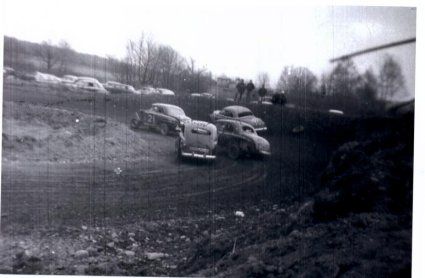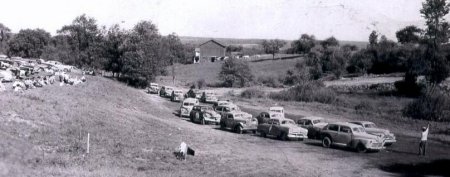by Randy Anderson
August 2007
Roll-O-Bowl Speedway

Roll-O-Bowl Speedway, where the name itself conjured up images of thrilling racing action and the owners paid $5.00 to any driver that rolled his car over during a race, was a typical 50's era jalopy track, more obstacle course than speedway, located on the Button Valley Road between Watts Flats and Panama, New York. The usual Sunday afternoon racing program offered thrilling side-by-side, bumping and shoving competition for the several hundred fans that plunked down $1.25 to see their favorite drivers hurl crude racing machines around the oddly shaped quarter-mile track. The young daredevils who piloted their homemade creations ventured a pit fee of $2.00 in search of $10.00 for a heat race win and $35.00 for the feature victory. One former competitor remarked, "I won enough money one Sunday to pay for my entire race car!" How many present day racers can say that?
Roll-O-Bowl was the brainchild of two brothers, Howard and Don McNitt, who began construction of the racetrack on their grandmother's farm in 1955. The track was patterned after the defunct Satan's Bowl of Death Speedway that had been located on the nearby Busti-Sugar Grove Road. Most of the original grading work for Roll-O-Bowl was done by Leon James, who also produced six sons, Clyde, Louie, Walt, Roy, Alvin, and Don, all of whom became racecar drivers at the track. The course was designed by the McNitts with the back straightaway higher than the front stretch, resulting in the cars having to race uphill between turns one and two, then downhill between turns three and four. However the most notable feature of the track was the creek that bisected the oval from one end to the other. This natural hazard forced the drivers to steer their jalopies through the water, twice on each lap. Former driver Budd Yeager recalls painting the spark plugs, coil, and distributor with shellac to keep the ignition system on his car dry. Following the '56 season, wooden planks were laid over the creek.
The racers who competed at Roll-O-Bowl were mostly local boys from the surrounding rural area. Many towed their racecars to the track with chains lashed to the bumpers of their family cars. Budd Yeager remembers towing three cars chained together behind his farm tractor. Other racers towed their cars to the track, but then didn't take them home. They were just left in the pits until the next week. Blinky Litzinger laughingly relates that he "must have had a pretty fancy operation because we had a towbar!" The field of racecars was comprised of former family sedans, junkyard coupes, and farmyard field cars that had outlived their previous purposes, but with a few minor modifications were turned into roaring jalopies.

Despite the crude cars and rough and tumble nature of the facility, former participants remember very few serious injuries. Veteran driver Jim Scott does, however, recalls one injury that led to an unusual conclusion. During his fateful race, Jim lost the brakes on his car rounding turn three. Jim attempted to downshift to slow his rate of speed, but his racer nose-dived into the bank at the bottom of turn four. His head jerked forward, slamming his face into the steering wheel and knocking out several teeth. Another car, driven by Bob Long, was unable to avoid the wreck and landed on top of the damaged Scott machine. Both drivers were removed from their cars and placed in the back of a station wagon that served as the track's ambulance. On the way to the hospital, Scott glanced over at Long and saw that the driver's steel helmet was broken apart. Not only was the helmet split open like a watermelon, so was Bob's scalp. Jim relates, "I could see the skin from his head falling over his ears." After being treated and released, Jim returned to his home in Garland, PA where his father reminded him that he had a grave to dig for a morning burial. Because he needed the extra money the assignment paid, Jim dutifully grabbed his pick and shovel and headed for the nearby cemetery. Upon commencing to dig, Jim was dismayed to learn that the proposed site was full of stone. Each blow of his pick or hammer sent waves of pain through the mouth of the injured driver. Realizing that he would be physically unable to complete the job by morning, the ingenious Mr. Scott returned home to retrieve a blasting cap and gunpowder. As Jim recounts the story, "It was a mighty fine hole!"
The most serious injury in the five-year history of Roll-O-Bowl did not occur during a racing event, but rather during pre-race track watering. A tractor pulling a hay wagon holding a large tank, served as the speedway's "water truck". Teenager Skip Furlow was in charge of tending the valve that opened the water tank at the designated times. On one particular Sunday, the tank became unleashed from its chains and rolled off the wagon and landed on the youthful valve tender. Skip spent four months in traction in a hospital and an equal amount of time in a body cast. Don McNitt recalls that the track's insurance company, Lloyd's of London, paid all associated medical bills. Skip recovered from his life-threatening injuries, built a racecar, and returned to his local track as a driver.
The McNitts had three very successful years operating their speedway. After the opening day race on May 30, 1956 won by Skip Covedill of Randolph, NY in a '41 Ford, the McNitts hosted seventeen more events that season. Among the most memorable races that year was the event won by Red McNitt, younger brother of the two owners, on July 8th. Red had funnelled his car's exhaust pipe through the roof of his machine and during the course of the race, the upholstery ignited. According to the Jamestown Post-Journal "the jaunty little redhead ignored the flames and sped to a quarter-lap victory".
In 1957, twenty-seven racing programs were contested with Dick Pangborn of Jamestown being declared the point champion in a season that ran from April to October. Among the added attractions that the McNitts presented were "powder puff races" featuring women drivers, "officials' races" where the drivers exchanged duties with track officials, and a "match race" featuring the six James boys competing against each other. Two of the most popular intermission stunts were the Rollover and the Wall of Fire. To perform the Rollover, Red McNitt would gun his stocker down through the third and fourth turns and then up the embankment along the front stretch in an attempt to see how many times he could roll his car over. For the Wall of Fire, a makeshift wooden wall stuffed with straw would be lit afire. Don McNitt, wearing only a helmet for protection, would lay spread-eagle across the hood of a car driven through the blazing inferno to the delight of the crowd. Don recalled, "It didn't hurt so bad once I figured out I should move back a ways on the hood."
The 1958 Roll-O-Bowl season was dominated by Johnny Whitehead of North Clymer, NY. The "Flying Farmer" recorded four feature wins, seven second-place finishes and four thirds out of eighteen total events in route to the championship. Johnny credits his former car owner and mechanic Al Maring with his success that year. Johnny recalls that his '47 Ford, coupe numbered 5, had "a light flywheel, shaved heads, and good shocks". Whitehead was also the '58 point champ at nearby Sherman Raceway.
After three very successful years, Roll-O-Bowl began to fall on hard times in 1959. Fewer racecars and fewer fans showed up for the Sunday afternoon shows. Don McNitt blamed a proliferation of other area jalopy tracks, while others mentioned the wildly successful late model cars at Stateline Speedway for the demise of the facility. For the 1960 season, the McNitts leased their track to Clair "Blinky" Litzinger and former track champion Dick Pangborn. Despite Herculean efforts by the two drivers turned promoters, Roll-O-Bowl closed for good after just six events. The final race, July 31, 1960, was won by rookie Ron Blackmer, driving a lightweight Frank Ruhlman creation consisting of a '37 Chevy body on a '53 Chevy frame.
Roll-O-Bowl Speedway may be gone, but it is not forgotten, Each September for the past several years, former driver and promoter Blinky Litzinger holds a reunion for his Roll-O-Bowl friends. And in 2007, the Harmony Historical Society, under the leadership of Pam Brown, and with the assistance of Greg Peterson and Randy Anderson, has begun to chronicle the history of the speedway by conducting primary source interviews with former participants. Through the efforts of Litzinger, Brown, Peterson, and Anderson the story behind Roll-O-Bowl, the track that launched the careers of successful late model racers, Skip Furlow, Ron Blackmer, Johnny Whitehead, Jim Scott, Marty Rater, and Stan Stevens will recorded for future generations of racing fans and local history buffs interested in viewing an almost obsolete picture of Americana.
The additional financial assistance of the community is critical to the success of the Chautauqua Sports Hall of Fame.
We gratefully acknowledge these individuals and organizations for their generous support.













